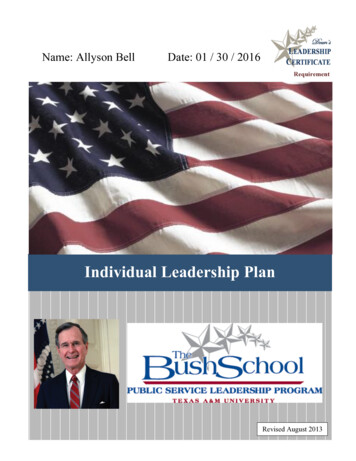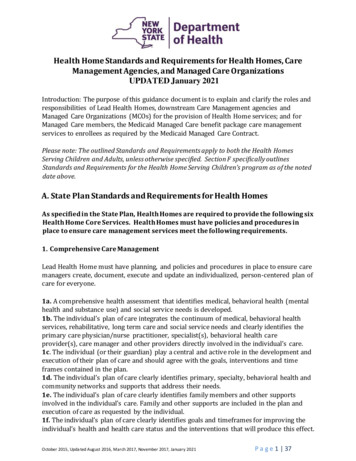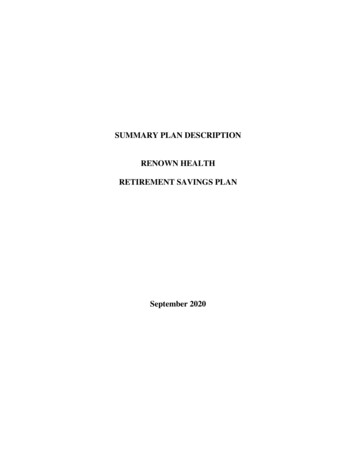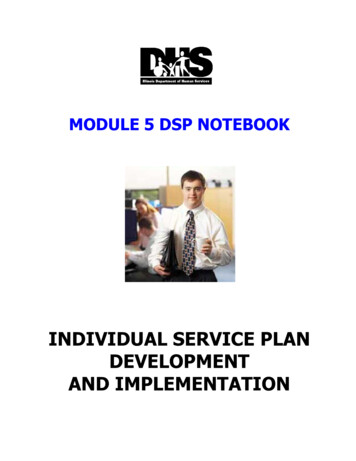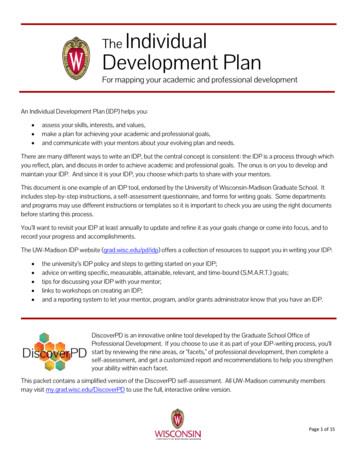
Transcription
IndividualDevelopment PlanTheFor mapping your academic and professional developmentAn Individual Development Plan (IDP) helps you: assess your skills, interests, and values,make a plan for achieving your academic and professional goals,and communicate with your mentors about your evolving plan and needs.There are many different ways to write an IDP, but the central concept is consistent: the IDP is a process through whichyou reflect, plan, and discuss in order to achieve academic and professional goals. The onus is on you to develop andmaintain your IDP. And since it is your IDP, you choose which parts to share with your mentors.This document is one example of an IDP tool, endorsed by the University of Wisconsin-Madison Graduate School. Itincludes step-by-step instructions, a self-assessment questionnaire, and forms for writing goals. Some departmentsand programs may use different instructions or templates so it is important to check you are using the right documentsbefore starting this process.You’ll want to revisit your IDP at least annually to update and refine it as your goals change or come into focus, and torecord your progress and accomplishments.The UW-Madison IDP website (grad.wisc.edu/pd/idp) offers a collection of resources to support you in writing your IDP: the university’s IDP policy and steps to getting started on your IDP;advice on writing specific, measurable, attainable, relevant, and time-bound (S.M.A.R.T.) goals;tips for discussing your IDP with your mentor;links to workshops on creating an IDP;and a reporting system to let your mentor, program, and/or grants administrator know that you have an IDP.DiscoverPD is an innovative online tool developed by the Graduate School Office ofProfessional Development. If you choose to use it as part of your IDP-writing process, you'llstart by reviewing the nine areas, or "facets," of professional development, then complete aself-assessment, and get a customized report and recommendations to help you strengthenyour ability within each facet.This packet contains a simplified version of the DiscoverPD self-assessment. All UW-Madison community membersmay visit my.grad.wisc.edu/DiscoverPD to use the full, interactive online version.Page 1 of 15
Basic steps of the IDPfor graduate students or postdoctoral researchers1for mentorsConduct a self-assessment.2 Write your Individual Development Plan.3 Discuss all or part of the IDP with your mentor.Update your information in the IDP reporting system,which helps PIs and staff verify IDP use.Review goals and helpmentee revise asneeded.4 Implement the plan.5 Revise and update your IDP as needed.Regularly review andprovide support.Icons on this page made by (descending order) Eucalyp, Gregor Cresnar, Freepik, Freepik, and Freepik from www.FlatIcon.com.Page 2 of 15
STEP 1: Conduct a self-assessmentStart the IDP process by taking some time to reflect on your skills.Static self-assessment option (located in this document): On pages 4 through 8, rate your confidence in your ability acrossnine areas of professional development. These areas, or “facets,” are from the DiscoverPD professional developmentframework.Inquiry, discovery, and creationDisciplinary expertise and interdisciplinaryconnectionsLeadershipCareer developmentManaging projects and peopleCommunicationValue for diversity and inclusionInterpersonal effectivenessPersonal effectivenessInteractive self-assessment option (my.grad.wisc.edu/DiscoverPD): All UW-Madison community members may use theonline DiscoverPD tool. On the homepage, take a moment to read about the nine facets of professional development. Thencomplete the self-assessment, and view your customized report of areas of strength and weakness. Remember to focus notonly on improving weaknesses but also on continuing to grow in areas where you are strong. Within your report, explore therecommended activities and favorite those that seem interesting. These get stored in My Favorites & Development Tracker.Keep these favorited activities close at hand and skip to page 9.Page 3 of 15
Self-assessmentOptional: Use the interactive self-assessment at my.grad.wisc.edu/DiscoverPD (requires UW-Madison netID).Rate your confidence in your ability to do the following activities.1 very unconfident; 2 somewhat unconfident; 3 neither unconfident nor confident; 4 somewhat confident; 5 very confidentInquiry, discovery, and creationInquiry, discovery, and creation describe characteristics of higher order thinking embodied by graduate students, includinganalyzing, evaluating, and creating.12345Create, invent, or produce new and innovative concepts or products Evaluate information, critique, and make judgments based on internal or externalevidence Pursue answers to complex questions Think and act innovatively to create opportunity Challenge conventional thinking Disciplinary expertise and interdisciplinary connectionsCore to graduate education, disciplinary expertise and interdisciplinary connections inform solutions to complex problems andcreating new knowledge.12345Achieve the learning outcomes of my academic program, as well as thosedefined for all UW-Madison graduate students Acquire depth and breadth of knowledge in my subject area Develop advanced skills in my subject area Work with peers and colleagues across disciplines Embrace the values of my profession Employ critical and analytical thinking and problem solving Obtain funding for my research or project Conduct myself ethically and professionally Seek and utilize information and technology resources appropriate to mydiscipline Page 4 of 15
Self-assessmentOptional: Use the interactive self-assessment at my.grad.wisc.edu/DiscoverPD (requires UW-Madison netID).Rate your confidence in your ability to do the following activities.1 very unconfident; 2 somewhat unconfident; 3 neither unconfident nor confident; 4 somewhat confident; 5 very confidentLeadershipLeadership occurs at all levels of successful organizations, regardless of formal authority or management role.12345Guide strategy and vision (e.g., on team projects) Move ideas into action Inspire others to new ways of thinking or acting Foster creativity and innovation in people around me Understand the dynamics of organizations Be proactive and take risks Acquire resources (e.g., get financial support from leadership, or collaborativesupport from others) Career developmentCareer development is a lifelong, proactive process of planning and implementation toward evolving, personally-definedcareer goals.12345Assess my skills, values, and interests Obtain mentorship Explore careers (e.g., conduct informational interviews) Market myself (e.g., utilize LinkedIn or other online platforms) Interview for jobs successfully Apply for job openings (e.g., writing a cover letter, resume, and/or CV) Participate in professional service Build and communicate my transferable skills to potential employers Take a lifelong approach to managing my career (e.g., utilizing an IDP,implementing both short- and long-term professional goals) Page 5 of 15
Self-assessmentOptional: Use the interactive self-assessment at my.grad.wisc.edu/DiscoverPD (requires UW-Madison netID).Rate your confidence in your ability to do the following activities.1 very unconfident; 2 somewhat unconfident; 3 neither unconfident nor confident; 4 somewhat confident; 5 very confidentManaging projects and peopleManaging projects and developing people’s potential requires an understanding of systematic approach methods, evaluation,and effective use of resources.12345Manage projects effectively by setting goals and monitoring results Supervise and/or mentor others Provide constructive feedback to others Manage financial resources (e.g., reading financial statements or budgeting) Employ systems and technology for productivity CommunicationCommunication is a bidirectional exchange of information, effective through understanding the intersection of media,audience, and message.12345Select and utilize optimal media for a particular message (e.g., when to usewritten, oral, visual, digital, smart media) Write for experts in my discipline Write for a lay audience (i.e., those who are not experts in my discipline) Creatively engage with the public about my scholarship or research Write effective grant proposals Utilize effective technical writing skills for my discipline Navigate the academic publishing landscape in my discipline Consult and listen well Page 6 of 15
Self-assessmentOptional: Use the interactive self-assessment at my.grad.wisc.edu/DiscoverPD (requires UW-Madison netID).Rate your confidence in your ability to do the following activities.1 very unconfident; 2 somewhat unconfident; 3 neither unconfident nor confident; 4 somewhat confident; 5 very confidentValue for diversity and inclusionTrue learning calls for free and open debate, requires respect of all individuals and ideas, and prepares students to live andwork in a world that speaks with many voices and from many backgrounds and experiences.12345Learn from and work effectively with people from cultural backgrounds differentfrom my own (i.e., demonstrate cultural competence)Learn from and work effectively with people from international backgrounds (i.e.,demonstrate global competence) Demonstrate equitable and inclusive leadership skills Promote equitable, inclusive, and respectful workplaces and/or classrooms Cultivate relationships with people from different backgrounds, experiences, andculturesRecognize differences and similarities as they enhance and enrich experiencesfor all Interpersonal effectivenessInterpersonal effectiveness entails recognizing and assessing the impact of one’s behavior on others, as well asunderstanding and cultivating positive relationships - e.g., with peers, coworkers, and advisors.12345Form teams and collaborate Appreciate, embrace, and/or foster the diverse perspectives of people around me Network effectively with others in a professional setting Negotiate (e.g., among people with conflicting ideas, salary negotiation) Resolve conflict between people or groups of people Mentor others (e.g., help to train undergraduates in my discipline) Help create a positive climate (i.e., a classroom or workplace where everyonefeels comfortable and appreciated) Work effectively with my faculty advisor, mentor, and/or supervisor Page 7 of 15
Self-assessmentOptional: Use the interactive self-assessment at my.grad.wisc.edu/DiscoverPD (requires UW-Madison netID).Rate your confidence in your ability to do the following activities.1 very unconfident; 2 somewhat unconfident; 3 neither unconfident nor confident; 4 somewhat confident; 5 very confidentPersonal effectivenessPersonal effectiveness describes a set of attitudes and attributes that are needed for lifelong career success.12345Maintain an openness to new ideas and perspectives Cultivate an attitude of curiosity and joy of discovery Stay motivated Demonstrate resilience Demonstrate integrity Think introspectively Engage in activities that improve conditions for others or help shape the future ofmy community (i.e., civic engagement) Be healthy physically, emotionally, and financially Manage my time effectively Stay organized in my academic, employment, and personal responsibilities Interpreting your responses to the self-assessmentIf you chose to complete the static self-assessment in this document, you’ll need to now review your responses. Take amoment to consider your responses on pages 4 through 8. Note subareas where you feel most confident (rated 4 or 5) andleast confident (rated 1 or 2). Circle any to which you feel committed to developing; these will be used in the goal-settingexercises on pages 11, 12, and 13.Page 8 of 15
Self-assessmentWhat are your current responsibilities and requirements?As part of the self-assessment process, ask yourself some questions related to your current responsibilities and requirements.Doing so will lead you to actions or goals to incorporate into your plan. Your aim is to develop skills that will lead to yoursuccess in your current position.What are the requirements and responsibilities you must meet during the next year? Two years?Are there particular technical skills or discipline-specific knowledge that you need to develop?Are there scholarly activities you would like to accomplish or work toward during the next year? Two years? (Examples: join aprofessional organization, present at a conference, co-author a paper )Other?Comments:Page 9 of 15
Self-assessmentWhat are your career aspirations?In preparation for creating a truly individualized IDP, ask yourself some questions related to your career goals. Consider usingvarious resources to see how your values and interests align with potential career goals. Some of these resources include:myIDP (myidp.sciencecareers.org) for STEM fields, Imagine PhD for arts and humanities (coming soon), and the GraduateSchool’s Alumni Career Paths (grad.wisc.edu/alumnicareers).What type of work would you like to do? What is important to you in your future career?What competencies are required for your chosen career?How well do your current skills match the competencies required for your chosen career?What are your short-term goals related to career exploration? (Examples: learn about science writing, conduct informationalinterviews, find out where graduates in my field are working/finding careers )How will you develop contacts--a network--related to your career exploration goals?Other?Comments:Page 10 of 15
STEP 2: Write the IDPThe IDP helps you map out the general path you want to take toward achieving your goals. The goals you include in your IDPare based on the strengths and weakness that you identified in step 1, together with the milestone activities that marksuccessful progress through your program (e.g., preparing for prelims), plus any other specific skills and knowledge needed toprepare for your career.Use the table on pages 12 and 13 as a starting point. You can expand and modify it to fit your own list of goals and strategies.For example, some mentees have transferred and expanded the table into an Excel spreadsheet to track multiple evolvinggoals over time.Be sure to identify specific and achievable objectives or skills, and write these in a way that makes very clear what you aregoing to do. Use a “S.M.A.R.T. Goals” format: Specific, Measurable, Attainable, Relevant, Time-bound.A specific goal will usually answer the five "W" questions:What: What do I want to accomplish?Why: Specific reasons, purpose or benefits of accomplishing the goalWho: Who is involved?Where: Identify a locationWhich: Identify requirements and constraintsA measurable goal will usually answer questions such as:How much? / How many? / How will I know when it is accomplished?An attainable goal will usually answer the question:How: How can the goal be accomplished?A relevant goal can answer yes to these questions:Does this seem worthwhile?Is this the right time?Am I the right person?Does this match my/our other efforts/needs?A time-bound goal will usually answer the questions:When?What can I do 6 months from now?What can I do 6 weeks from now?What can I do today?And remember, your IDP is a living document that will and should be updated and changed as often as necessaryMeyer, Paul J (2003). "What would you do if you knew you couldn’t fail? Creating S.M.A.R.T. Goals". Attitude Is Everything: If You Want to Succeed Above andBeyond. Meyer Resource Group, Incorporated.Page 11 of 15
Self-assessment summaryConfidentUnconfident(4’s and 5’s on pages 4-8)(1’s and 2’s on pages 4-8)Goals: current responsibilitiesDefine approaches and strategies below, and include a timeframe for beginning and completing these actions. Make sure tohave an outcome statement that is clear enough to allow someone (including you!) to know if you’ve met your objective.Objectives or skills Approaches andto be learnedstrategiesTimeframeOutcomesPage 12 of 15
Goals: career aspirationsDefine approaches and strategies below, and include a timeframe for beginning and completing these actions. Make sure tohave an outcome statement that is clear enough to allow someone (including you!) to know if you’ve met your objective.Objectives or skills to Approaches andbe learnedstrategiesTimeframeOutcomesGoal prioritizationLong term (more than 6 months away)Low priorityHigh priorityNear term (within the next 6 months)Page 13 of 15
STEP 3: Discuss with MentorDiscussing what you discovered from your skills assessment, and talking about your career goals and interests with yourmentor might help you identify developmental needs and areas to work on. By helping you compare current skills andstrengths with those needed to achieve your career objectives, your mentor can be an important ally.Some might feel it’s risky to share, for example, their weaknesses or their interest in a career outside academia with theirmentor. While it’s not necessary to share all results right away, consider how the feedback from your mentor might supportyour plan, and provide insights and resource ideas.It is strongly recommended that you discuss your plan with your primary mentor but also be creative about whom youapproach for advice. You can get useful feedback from multiple people with a broad range of experiences and perspectivesincluding friends, family, staff and faculty other than your primary mentor.See the university’s IDP website (grad.wisc.edu/pd/idp/menteetips) for other tips on the discussion with your mentor.The university has created an IDP Reporting System (my.gradsch.wisc.edu/idp/myUWIDP.pl) to let your mentor, grad/trainingprogram, and/or grants administrator know that you have an IDP if requested. Visit the university’s IDP website for moreinformation on this process.Page 14 of 15
STEP 4: Implement the PlanPut your plan into action. Stay organized and seek out the support you need to stay on track. Commit to the plan, but alsoremember that you will need to be flexible and modify your plan as your goals or circumstances change. Keep your IDP in aconvenient place and check it often. Add your IDP deadlines to your calendar to integrate them with deadlines for other workand personal events.STEP 5: Review and Revise Your IDPReview the IDP with your mentor on a regular basis (on a schedule decided upon together) and revise/update. At a minimum,you should revisit and discuss your IDP with your mentor annually.And, importantly, celebrate your achievements!Your name:Today’s date:Adapted from:Federation of American Societies of Experimental Biology (FASEB) IDP for Postdoctoral Fellows: faseb.org/portals/2/pdfs/opa/idp.pdfmyIDP website: myidp.sciencecareers.orgIndividual Development Plan for UCSF FacultyIndividual Development Plan for Case Western Reserve University Postdoctoral Trainees postdoc.case.edu/current/careers.htmlThe National Postdoctoral Association Postdoctoral Core Competencies: www.nationalpostdoc.org/competenciesUniversity of Wisconsin-Madison Graduate School Office of Professional Development, DiscoverPD: my.grad.wisc.edu/DiscoverPDPage 15 of 15
The Individual Development Plan . For mapping your academic and professional development. An Individual Development Plan (IDP) helps you: assess your skills, interests, and values, make a plan for achieving your academic and professional goals, and communicate with your mentors about your evolving plan and needs.



